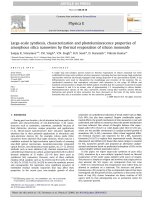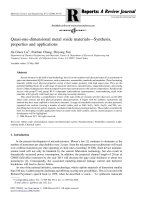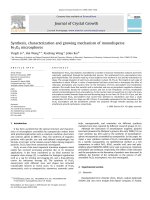syndiotactic polystyrene synthesis characterization processing and applications
Bạn đang xem bản rút gọn của tài liệu. Xem và tải ngay bản đầy đủ của tài liệu tại đây (6.96 MB, 487 trang )
SYNDIOTACTIC
POLYSTYRENE
SYNTHESIS, CHARACTERIZATION,
PROCESSING, AND APPLICATIONS
Edited by
Jürgen Schellenberg
R&D Dow Central Germany
Dow Olefi nverbund GmbH, Schkopau, Germany
A John Wiley & Sons, Inc., Publication
SYNDIOTACTIC
POLYSTYRENE
New supramolecular structure of syndio-
tactic polystyrene showing a “bird’s-
nest-like” structure, obtained from a
cyclohexanol solution by thermally
induced phase separation (scanning
electron microscope image by M. van
Heeringen, Dow Terneuzen) (Van
Heeringen, M., Vastenhout, B., Koopmans,
R., Aerts, L. e-Polymers [2005], no. 048.)
SYNDIOTACTIC
POLYSTYRENE
SYNTHESIS, CHARACTERIZATION,
PROCESSING, AND APPLICATIONS
Edited by
Jürgen Schellenberg
R&D Dow Central Germany
Dow Olefi nverbund GmbH, Schkopau, Germany
A John Wiley & Sons, Inc., Publication
Cover image: Scanning electron micrographs of syndiotactic polystyrene prepared by a powder
bed polymerization process showing the typical “caulifl ower” structure of the powder (SEM:
Dow Central Germany).
Copyright © 2010 by John Wiley & Sons, Inc. All rights reserved.
Published by John Wiley & Sons, Inc., Hoboken, New Jersey.
Published simultaneously in Canada.
No part of this publication may be reproduced, stored in a retrieval system, or transmitted in
any form or by any means, electronic, mechanical, photocopying, recording, scanning, or
otherwise, except as permitted under Section 107 or 108 of the 1976 United States Copyright
Act, without either the prior written permission of the Publisher, or authorization through
payment of the appropriate per-copy fee to the Copyright Clearance Center, Inc., 222
Rosewood Drive, Danvers, MA 01923, (978) 750-8400, fax (978) 750-4470, or on the web at
www.copyright.com. Requests to the Publisher for permission should be addressed to the
Permissions Department, John Wiley & Sons, Inc., 111 River Street, Hoboken, NJ 07030, (201)
748-6011, fax (201) 748-6008, or online at igo/permission.
Limit of Liability/Disclaimer of Warranty: While the publisher and author have used their best
efforts in preparing this book, they make no representations or warranties with respect to the
accuracy or completeness of the contents of this book and specifi cally disclaim any implied
warranties of merchantability or fi tness for a particular purpose. No warranty may be created
or extended by sales representatives or written sales materials. The advice and strategies
contained herein may not be suitable for your situation. You should consult with a professional
where appropriate. Neither the publisher nor author shall be liable for any loss of profi t or any
other commercial damages, including but not limited to special, incidental, consequential, or
other damages.
For general information on our other products and services or for technical support, please
contact our Customer Care Department within the United States at (800) 762-2974, outside the
United States at (317) 572-3993 or fax (317) 572-4002.
Wiley also publishes its books in a variety of electronic formats. Some content that appears in
print may not be available in electronic formats. For more information about Wiley products,
visit our web site at www.wiley.com.
Library of Congress Cataloging-in-Publication Data:
Schellenberg, Jürgen.
Syndiotactic polystyrene : synthesis, characterization, processing, and applications /
Jürgen Schellenberg.
p. cm.
Includes index.
ISBN 978-0-470-28688-3 (cloth)
1. Polystyrene. 2. Microcrystalline polymers. I. Title.
TP1183.M5S34 2010
668.4'233–dc22
2009020802
Printed in the United States of America.
10 9 8 7 6 5 4 3 2 1
Dedicated to Prof. Dr. habil. Joachim Ulbricht,
a Pioneer in the Fields of Polymer Chemistry
and Coordination Polymerization
CONTENTS
vii
PREFACE xvii
CONTRIBUTORS xxi
ABOUT THE EDITOR xxv
PART I INTRODUCTION 1
1. Historical Overview and Commercialization of Syndiotactic
Polystyrene 3
Michael Malanga, Osamu Isogai, Takeshi Yamada, Shigeo Iwasaki, and
Masahiko Kuramoto
1.1 Discovery of Syndiotactic Polystyrene (SPS) 3
1.2 Early Years of Development (1985–1989) 5
1.3 Intense Development Years (1989–1996) 6
1.4 Initial Commercial Launch Stage (1996–2001) 12
1.5 Years 2001–2007 13
PART II PREPARATION OF SYNDIOTACTIC POLYSTYRENE 15
2. Transition Metal Catalysts for Syndiotactic Polystyrene 17
Norio Tomotsu, Thomas H. Newman, Mizutomo Takeuchi,
Richard Campbell Jr., and Jürgen Schellenberg
2.1 Introduction 17
2.2 Transition Metal Compounds 18
2.2.1 Metals 18
2.2.2 Titanium Complexes 19
2.2.3 Molecular Weight Control 26
2.2.4 Supported and Heterogeneous Catalysts 27
2.3 Summary 29
References 29
viii CONTENTS
3. Cocatalysts for the Syndiospecifi c Styrene Polymerization 32
Norio Tomotsu, Hiroshi Maezawa, and Thomas H. Newman
3.1 Introduction 32
3.2 MAO 32
3.3 Boron Compounds 36
3.4 Other Chemicals 39
3.5 Summary 40
References 40
4. Mechanisms for Stereochemical Control in the Syndiotactic
Polymerization of Styrene 42
Norio Tomotsu, Thomas H. Newman, and Richard Campbell Jr.
4.1 Introduction 42
4.2 Insertion of the Growing Polymer Chain into the Double
Bond of Styrene 42
4.3 Stereochemistry of the Styrene Insertion 45
4.4 Effects of Hydrogenation of the Catalyst 47
4.5 Active Site Species 48
4.5.1 Valence of Active Sites 48
4.5.2 Number of Active Sites 52
4.5.3 Structure of Active Sites 53
4.6 Theoretical Analysis of the Catalyst 54
4.7 Kinetic Analysis of Styrene Polymerization 54
4.8 Conclusions 57
References 58
5. Copolymerization of Ethylene with Styrene: Design of Effi cient
Transition Metal Complex Catalysts 60
Kotohiro Nomura
5.1 Introduction 60
5.2 Ethylene/Styrene Copolymers: Microstructures, Thermal
Properties, and Composition Analyses 61
5.3 Ethylene/Styrene Copolymerization Using Transition Metal
Complex–Cocatalyst Systems 64
5.3.1 Half-Titanocenes, Cp′TiX
3
64
5.3.2 Linked (Constrained Geometry Type)
Half-Titanocenes 65
5.3.3 Modifi ed Half-Titanocenes, Cp′Ti(L)X
2
71
CONTENTS ix
5.3.4 Non-Cp Titanium Complexes 79
5.3.5 Metallocenes 83
5.3.6 Others 85
5.4 Summary and Outlook 86
References 87
6. Structure and Properties of Tetrabenzo[a,c,g,i]fl uorenyl-Based
Titanium Catalysts 92
Rüdiger Beckhaus, Kai Schröder, and Jürgen Schellenberg
6.1 Introduction 92
6.2 The Tbf Ligand 94
6.3 Tbf Lithium 96
6.3.1 Synthesis and Characterization of Tbf Lithium 96
6.4 Tbf Titanium(III) Derivatives 98
6.4.1 Synthesis of Tbf Titanium(III) Chloride
Complexes 98
6.4.2 Reaction of TbfTi
III
Cl
2
(THF) (VIII) with
Radicals 102
6.5 Tbf Titanium(IV) Derivatives 105
6.5.1 Synthesis of Tbf Titanium Monophenoxide
Complexes 107
6.6 Dynamic and Polymerization Behavior of
Tetrabenzofl uorenyl Titanium Complexes 117
6.6.1 Styrene Polymerization 119
6.7 Conclusions 120
References 120
7. Rare-Earth Metal Complexes as Catalysts for Syndiospecifi c
Styrene Polymerization 125
Klaus Beckerle and Jun Okuda
7.1 Introduction 125
7.2 Metallocene Catalysts 126
7.3 Constrained Geometry Catalysts 129
7.4 Half-Sandwich Catalysts 130
7.5 Nonmetallocene Catalysts 134
7.6 Conclusion 136
References 136
x CONTENTS
8. Syndiospecifi c Styrene Polymerization with Heterogenized
Transition Metal Catalysts 140
Kyu Yong Choi
8.1 Introduction 140
8.2 Kinetics of Syndiospecifi c Polymerization with
Heterogeneous Metallocene Catalysts 141
8.2.1 Kinetic Profi les of Heterogeneous SPS
Polymerization 141
8.2.2 Liquid Slurry Polymerization with Heterogenized
Cp*Ti(OCH
3
)
3
Catalyst 143
8.2.3 Modeling of Polymerization Kinetics 145
8.2.4 Molecular Weight Distribution of SPS with
Heterogeneous Catalysts 147
8.3 Nascent Morphology of Syndiotactic Polystyrene 149
8.3.1 Physical Transitions of Reaction Mixture During
Polymerization 149
8.3.2 Effect of Reaction Conditions on Polymer
Morphology 151
8.4 Concluding Remarks 153
References 153
PART III STRUCTURE AND FUNDAMENTAL PROPERTIES
OF SYNDIOTACTIC POLYSTYRENE 155
9. Structure, Morphology, and Crystallization Behavior of
Syndiotactic Polystyrene 157
Andrea Sorrentino and Vittoria Vittoria
9.1 Introduction 157
9.2 Polymorphic Behavior of SPS 157
9.2.1 Crystallization from the Melt State 159
9.2.2 Crystallization from the Glassy State 160
9.2.3 Morphology Development in the Presence of
Solvents 163
9.3 Morphology of the Zigzag Forms 164
9.3.1 Crystal Structure of the α Form 164
9.3.2 Crystal Structure of the β Form 168
9.3.3 Lamellar and Spherulitic Morphology of the
Zigzag Forms 170
CONTENTS xi
9.4 Morphology of the Mesomorphic Phases 173
9.5 Thermodynamic and Kinetics of Crystallization 175
9.5.1 Thermodynamic and Kinetics of Crystallization 177
9.6 Melting Behavior 178
9.6.1 Equilibrium Melting Temperature of α and β
Crystals 180
9.6.2 Memory Effects 182
9.7 Structure and Properties of the Crystallized Samples 183
9.7.1 Morphology of Injection Molded Samples 183
9.7.2 Relation between Morphology Structure,
Processing, and Properties 184
References 186
10. Preparation, Structure, Properties, and Applications of Co-Crystals
and Nanoporous Crystalline Phases of Syndiotactic Polystyrene 194
Gaetano Guerra, Alexandra Romina Albunia, and Concetta D’Aniello
10.1 Introduction 194
10.2 Co-Crystals 195
10.2.1 Crystalline Structures 196
10.2.2 Processing and Materials 199
10.2.3 Characterization Studies 202
10.2.4 Properties and Applications 209
10.3 Nanoporous Crystalline Phases 212
10.3.1 Crystalline Structures 213
10.3.2 Processing and Materials 215
10.3.3 Characterization Studies 217
10.3.4 Applications 219
10.4 Conclusions and Perspectives 224
10.5 Acknowledgments 225
References 225
11. Crystallization Thermodynamics and Kinetics of Syndiotactic
Polystyrene 238
Tomoaki Takebe and Komei Yamasaki
11.1 Introduction 238
11.2 Theoretical Background 239
11.3 Equilibrium Melting Point of SPS 240
11.3.1 Evaluation of Spherulitic Growth Rate G 244
xii CONTENTS
11.4 Analyses of Spherulitic Growth Rate G 248
11.5 Comparison Between SPS and IPS 249
References 250
PART IV COMMERCIAL PROCESSES FOR MANUFACTURING
OF SYNDIOTACTIC POLYSTYRENE 253
12. Processes for the Production of Syndiotactic Polystyrene 255
Masao Aida, David Habermann, Hans-Joachim Leder,and
Jürgen Schellenberg
12.1 Introduction 255
12.2 Monomer Purifi cation Section 255
12.3 Catalyst Section 256
12.4 Polymerization Section 256
12.4.1 Continuous Stirred Tank Reactor Process 257
12.4.2 Continuous Fluidized Bed Reactor Process 258
12.4.3 Continuous Self-Cleaning Reactor Process 258
12.5 Styrene Stripping Section 260
12.6 Deactivating Section 260
12.7 Pelletizing Section 262
12.8 Blending Section 262
12.9 Shipping Section 263
References 264
PART V PROPERTIES, PROCESSING, AND APPLICATIONS
OF SYNDIOTACTIC POLYSTYRENE 267
13. Properties of Syndiotactic Polystyrene 269
Tomoaki Takebe, Komei Yamasaki, Keisuke Funaki, and Michael Malanga
13.1 Introduction 269
13.2 Rheological Properties of SPS 269
13.3 Basic Physical Mechanical Properties of SPS 272
13.3.1 Thermal Properties of SPS 272
13.3.2 Mechanical Properties of SPS 274
13.4 Orientation of SPS and Properties of Oriented SPS 281
13.4.1 Properties of Uniaxially Oriented SPS 281
13.4.2 Properties of Biaxially Oriented SPS (BoSPS) 282
CONTENTS xiii
13.5 Other Important Properties of SPS 286
13.5.1 Electrical Properties of SPS 286
13.5.2 Chemical Resistance of SPS 287
References 289
14. Melt Processing of Syndiotactic Polystyrene 290
David Bank, Kevin Nichols, Harold Fowler, Jason Reese,and
Gerry Billovits
14.1 Introduction 290
14.2 Compounding 294
14.2.1 Introduction 294
14.2.2 Compounding Equipment 295
14.2.3 Compounding Process Conditions 296
14.3 Injection Molding 298
14.3.1 Introduction 298
14.3.2 General Product Design 299
14.3.3 Thin Wall Product Designs 301
14.3.4 Injection Mold Design 301
14.3.5 Injection Mold Melt Delivery System (Runners
and Gates) 302
14.3.6 Venting 304
14.3.7 Injection Molding Cooling Cycle and
Crystallinity 304
14.3.8 Shrinkage during the Cooling Phase 304
14.3.9 Injection Molding Process Set-up 306
14.3.10 Injection Molding Cycle 308
14.3.11 Special Injection Molding Cycles 310
14.4 Sheet and Film Extrusion 311
14.4.1 Introduction 311
14.4.2 Extrusion 311
14.4.3 General Extruder Design 312
14.4.4 Processing Parameters 313
14.4.5 Material Drying 314
14.5 Film Processing and Fabrication 314
14.5.1 Introduction 314
14.5.2 Cast Film Extrusion 314
14.5.3 Thermoforming 315
14.6 Fiber Spinning 316
References 319
xiv CONTENTS
15. Applications of Syndiotactic Polystyrene 321
Tom Fiola, Akihiko Okada, Masami Mihara, and Kevin Nichols
15.1 Introduction 321
15.2 The Performance Capabilities of SPS 322
15.3 Connectors for Automotive and Electronic Applications 329
15.4 Electronic Components: Plated and Non-Plated 330
15.5 Industrial and Appliance Components 331
References 337
16. Blends of Syndiotactic Polystyrene with Polyamide 338
Kevin Nichols, Akihiko Okada, and Hiroki Fukui
16.1 Introduction 338
16.2 Composition of SPS/Nylon Blends 338
16.2.1 Polyamides Used in SPS/Nylon Blends 339
16.2.2 SPS/Nylon Blend Formulations 339
16.2.3 SPS/Nylon Blend Composition Patents 339
16.2.4 SPS/Nylon Blend Compositions Described in
Technical Journals 339
16.3 Properties of SPS/Nylon Blends 339
16.3.1 Mechanical Properties of SPS/Nylon Blends 340
16.3.2 Rheology of SPS/Nylon Blends 343
16.3.3 Moisture Absorption and Moisture Growth of
SPS/Nylon Blends 343
16.3.4 Dimensional Stability of SPS/Nylon Blends 346
16.3.5 USCAR Performance of SPS/Nylon Blends 347
16.3.6 Environmental Stress Crack Resistance of
SPS/Nylon Blends 349
16.4 Applications of SPS/Nylon Blends 349
16.4.1 SPS/Nylon Blend Under-the-hood Automotive
Connectors 349
16.4.2 SPS/Nylon Blend Carpet Fibers 350
16.4.3 SPS/Nylon Blend Application Patents 353
References 355
17. Blends of Syndiotactic Polystyrene with Polystyrenes 360
Tomoaki Takebe, Komei Yamasaki, Akihiko Okada, and
Takuma Aoyama
17.1 Introduction 360
17.2 SANS Measurements 361
CONTENTS xv
17.3 Theoretical Background 361
17.4 Tacticity Effect on Miscibility 363
17.5 Properties of Blends of SPS and APS 366
References 370
18. Compatibilizers for Impact-Modifi ed Syndiotactic Polystyrene 371
Tomoaki Takebe, Akihiko Okada, and Nobuyuki Sato
18.1 Introduction 371
18.2 Morphological Analyses of HISPS 372
18.2.1 SAXS Profi les of HISPS in the Crystalline State 374
18.2.2 Effect of Nucleators on Lamellar Orientation
in HISPS 375
18.3 Morphology of SPS/PPO Binary Blends 376
18.3.1 Structural Analyses Using SAXS Technique 377
18.3.2 Crystallization Kinetics of SPS/PPO Blends 378
18.3.3 Infl uence of Blending PPO with Different
Molecular Weights on the Morphology of HISPS 380
18.4 Compatibilizer Effects 382
18.4.1 Evaluation of Interaction Parameters 383
18.4.2 Evaluation of Domain Size and Interfacial
Thickness 388
References 393
PART VI POLYMERS BASED ON SYNDIOTACTIC
POLYSTYRENES 395
19. Functionalization and Block/Graft Reactions of Syndiotactic
Polystyrene Using Borane Comonomers and Chain Transfer
Agents 397
T. C. Mike Chung
19.1 Introduction 397
19.2 Functionalization of SPS via Borane Comonomers 398
19.2.1 Copolymerization of Styrene and B-styrene 398
19.2.2 Side-Chain Functionalized SPS Polymers 402
19.2.3 SPS Graft Copolymers 406
19.3 Functionalization of SPS via Borane Chain Transfer
Agents 409
19.3.1 SPS Containing a Terminal Functional Group 410
19.3.2 SPS Block Copolymers 412
xvi CONTENTS
19.4 Summary 415
19.5 Acknowledgment 415
References 415
20. Nanocomposites Based on Syndiotactic Polystyrene 417
O Ok Park and Mun Ho Kim
20.1 Introduction 417
20.2 Polymer Nanocomposites and Microstructure 418
20.3 Fabrication of Polymer Nanocomposites 419
20.4 Characterization of Polymer Nanocomposites 420
20.5 Preparation of SPS Nanocomposites 421
20.5.1 Effect of Alkyl Chain Aggregation in
Organoclay—Bilayer versus Monolayer
Arrangement 423
20.5.2 Improvement in the Thermal Stability of
Organoclay 424
20.6 Properties of SPS Nanocomposites 425
20.6.1 Mechanical Properties 425
20.6.2 Crystallization Behavior 426
20.6.3 Dynamic Rheological Properties 426
20.7 Final Remarks 427
References 429
INDEX 431
Preface
xvii
In 1953, Karl Ziegler discovered that selected transition metal compounds can
be activated by aluminum alkyls and can be used as organometallic catalysts
to polymerize ethylene. One year later, Giulio Natta synthesized further ste-
reoregular polymers such as polypropylene. Both scientists were awarded the
Nobel Prize for Chemistry in 1963. Their fundamental work resulted in a
signifi cant increase in research intensity and in an immediate commercializa-
tion of these polymers.
After these discoveries, one of the most important achievements in coor-
dination polymerization chemistry has been the introduction of methylalumi-
noxanes as a new class of aluminum alkyl activators by Sinn and Kaminsky at
the end of the 1970s, prepared by controlled hydrolysis of methylaluminum
alkyls. Such cocatalysts together with metallocene compounds led to an out-
standing enhancement of polymerization activity and effi ciency and to a con-
siderable improvement of the molecular uniformity of the polymers obtained.
Thus, methylaluminoxanes together with metallocene catalysts allowed the
synthesis of highly stereoregular and stereoblock polypropylenes, ethylene
copolymers with a higher content of comonomer or with higher α - olefi ns and
other monomers, cycloolefi n polymers of high crystallinity and their copoly-
mers, as well as polyethylenes with improved rheological properties by con-
trolled long - chain branching.
As a result of these developments, syndiotactic polystyrene (SPS) was pre-
pared by activated titanium compounds as polymerization catalysts. The fi rst
SPS was synthesized by Ishihara et al. in 1985 using a homogeneous organo-
metallic catalytic system based on titanium compounds and methylaluminox-
ane as cocatalyst. The polystyrene initially obtained was a polymer with a
2 - butanone - insoluble content as a measure of the syndiotacticity of 98 wt%, a
weight - average molecular weight of 82,000 g/mol, and a melting temperature
of about 270 ° C, 40 ° C higher than that of the isotactic polystyrene known
since 1955.
However, the most important advantage of this SPS in comparison to the
isotactic polymer is the much higher crystallization rate of the polymer melt,
comparable to that of polyethylene. This high crystallization rate enabled an
advantageous processing of the polymer by extrusion and injection molding
techniques. After the development of commercially viable transition metal
catalysts with high polymerization activity, this new, highly stereoregular
polymer was successfully commercialized in 1999. Further desirable properties
xviii PREFACE
of this polymer are high heat resistance based on the high melting temperature
of 270 ° C; excellent chemical resistance to reagents including acids, bases, oils,
water, and steam; good electrical properties as insulating materials with a low
dielectric constant and a low dissipation factor; low polymer density of 1.05 g/
cm
3
with nearly equivalent densities in crystalline and amorphous regions;
excellent processing characteristics at a very low melt viscosity; outstanding
dimensional stability; and low moisture absorption. The less desirable brittle-
ness of SPS has been overcome by reinforcement with glass fi bers, altogether
leading to an advantageous new polymer in the class of semicrystalline engi-
neering thermoplastics.
This book comprehensively covers all aspects of SPS, from the synthesis of
this new polymer by coordination polymerization to the characterization of
structure, properties, and behavior of the neat material as well as of plastic
materials, including the different processing opportunities of such materials,
to the widely diversifi ed applications of polymers and blends, also considering
SPS - based polymers.
The Introduction gives a historical overview of SPS from the fi rst discovery
through developmental stages to the full commercialization of this polymer
based on an inexpensive monomer (Chapter 1 ). Because the transition metal
catalysts for the coordination polymerization of styrene are of high impor-
tance for the properties of the polymers, these catalysts are comprehensively
covered in the section on the preparation of SPS.
After an overview of the transition metal catalysts for SPS, primarily half -
metallocenes of group 4, in Chapter 2 , details on cocatalysts for SPS are given
in Chapter 3 followed by an overview on mechanism and kinetics of the syn-
diospecifi c styrene polymerization, including active site formation, in Chapter
4 . The design of effi cient transition metal complex catalysts for the copoly-
merization of ethylene with styrene is described in Chapter 5 . The subsequent
chapters include some selected groups of special transition metal catalysts,
such as novel tetrabenzo[ a,c,g,i ]fl uorenyl - based titanium catalysts as deriva-
tives of the highly effi cient hydrogenated fl uorenyl catalysts (Chapter 6 ), rare -
earth metal complexes (Chapter 7 ), and heterogenized transition metal
catalysts (Chapter 8 ).
In the section on structure and fundamental properties of SPS, Chapter 9
summarizes the polymorphic behavior of this polymer, the structure of the
different forms, and the crystallization and melting behavior. Chapter 10
describes co - crystals and nanoporous crystalline phases of SPS regarding
preparation, structure, properties, and new interesting applications, for
example, molecular sensors. The section concludes with Chapter 11 on selected
topics of crystallization thermodynamics and kinetics of SPS.
The next section on commercial processes for manufacturing of SPS
describes the process for the production of this polymer in more detail
(Chapter 12 ).
The comprehensive section on properties, processing, and application of
SPS discusses the rheological, mechanical, and other properties of this polymer
PREFACE xix
(Chapter 13 ) and continues with melt processing, including injection molding,
extrusion, fi lms, and fi bers (Chapter 14 ). Chapter 15 goes on to describe appli-
cations of SPS polymers themselves, followed by a discussion of blends with
polyamides in Chapter 16 and with conventional polystyrenes in Chapter 17 .
Compatibilizers for impact - modifi ed SPS are covered in Chapter 18 .
The last section on polymers based on SPS includes the different opportuni-
ties for functionalization and modifi cation of SPS in Chapter 19 and nanocom-
posites based on SPS described in Chapter 20 .
The intent of this book is to provide the reader with comprehensive knowl-
edge about SPS based on a historical overview on this polymer, not only by
summarizing the fundamentals of this stereoregular polymer but also by
describing the latest new developments in this area. However, this book
cannot be exhaustive because of the very broad interest this polymer has
received in academic research as well as in industry.
Gratefully acknowledged is the excellent work done by all authors, as well
as the successful collaboration with the publisher, John Wiley & Sons, Inc., at
all stages of the preparation and publishing of this book.
J ü rgen S chellenberg
March 2009
Contributors
xxi
Masao Aida , Process Development Center, Idemitsu Kosan Co., Ltd., Chiba,
Japan
Alexandra Romina Albunia , Dipartimento di Chimica, University of Salerno,
Fisciano (SA), Italy
Takuma Aoyama , Xarec and SPS Products, Idemitsu Chemicals USA
Corporation, Southfi eld, MI, USA
David Bank , Dow Automotive R & D, The Dow Chemical Company, Midland,
MI, USA
Klaus Beckerle , RWTH Aachen University, Aachen, Germany
R ü diger Beckhaus , Institute of Pure and Applied Chemistry, Carl von
Ossietzky University, Oldenburg, Germany
Gerry Billovits , Core R & D New Products, The Dow Chemical Company,
Midland, MI, USA
Richard Campbell Jr ., Chemical Sciences, The Dow Chemical Company,
Midland, MI, USA
Kyu Yong Choi , Department of Chemical and Biomolecular Engineering,
University of Maryland, College Park, MD, USA
T. C. Mike Chung , Department of Materials Science and Engineering, The
Pennsylvania State University, University Park, PA, USA
Concetta D ’ Aniello , Dipartimento di Chimica, University of Salerno, Fisciano
(SA), Italy
Tom Fiola , Xarec and SPS Products, Idemitsu Chemicals USA Corporation,
Southfi eld, MI, USA
Harold Fowler , Ventures & Business Development, The Dow Chemical
Company, Midland, MI, USA
xxii CONTRIBUTORS
Hiroki Fukui , PP Automotive Materials Division, Prime Polymer Co., Ltd.,
Shizuoka, Japan
Keisuke Funaki , Polymer Development Center, Idemitsu Kosan Co., Ltd.,
Chiba, Japan
Gaetano Guerra , Dipartimento di Chimica, University of Salerno, Fisciano
(SA), Italy
David Habermann , Information Systems Management, The Dow Chemical
Company, Midland, MI, USA
Osamu Isogai , Kukankoubou Co., Ltd., Chiba, Japan
Shigeo Iwasaki , Technology and Engineering Department, Idemitsu Kosan
Co., Ltd., Chiba, Japan
Mun Ho Kim , Department of Chemical and Biomolecular Engineering,
Korea Advanced Institute of Science and Technology, Daejeon, Korea
Masahiko Kuramoto , Chemicals Development Center, Idemitsu Kosan Co.,
Ltd., Chiba, Japan
Hans - Joachim Leder , R & D Dow Central Germany, Dow Olefi nverbund
GmbH, Schkopau, Germany
Hiroshi Maezawa , Technology and Engineering Department, Idemitsu Kosan
Co., Ltd., Tokyo, Japan
Michael Malanga , R & D Advanced Technologies, The Dow Chemical
Company, Auburn Hills, MI, USA
Masami Mihara , Idemitsu Kosan Co., Ltd., Chiba, Japan
Thomas H. Newman , Science Division, Delta College, University Center, MI,
USA
Kevin Nichols , R & D Dow Building Solutions, The Dow Chemical Company,
Midland, MI, USA
Kotohiro Nomura , Graduate School of Materials Science, Nara Institute of
Science and Technology, Nara, Japan
Akihiko Okada , Engineering Plastics Department, Idemitsu Kosan Co., Ltd.,
Tokyo, Japan









